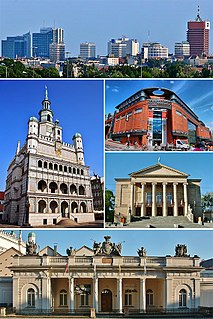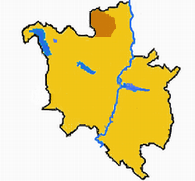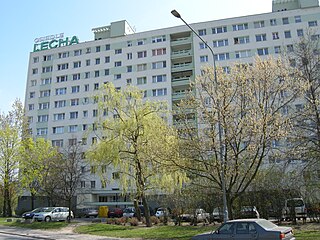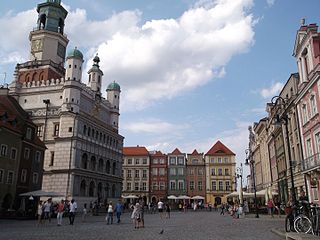

Winogrady [vinɔˈɡradɨ] is a part of the Stare Miasto district of the city of Poznań in western Poland. It is situated north of the Cytadela park (the former Poznań citadel). The name refers to the vineyards which formerly existed in the area – historically there were two villages there called Winiary (although "Winiary" today refers to a neighbourhood in Jeżyce district, to which the inhabitants were moved when the citadel fortifications were built in the 1830s).

Stare Miasto is a part of the city of Poznań in western Poland. It was one of the five governmental districts (dzielnicas) into which the city was divided prior to 1990, and which are retained for certain administrative purposes. For details, see Administrative division of Poznań.

Poznań is a city on the Warta River in west-central Poland, in the Greater Poland region and is the fifth-largest city in Poland. It is best known for its renaissance Old Town and Ostrów Tumski Cathedral. Today, Poznań is an important cultural and business centre and one of Poland's most populous regions with many regional customs such as Saint John's Fair, traditional Saint Martin's croissants and a local dialect.

Poland, officially the Republic of Poland, is a country located in Central Europe. It is divided into 16 administrative subdivisions, covering an area of 312,696 square kilometres (120,733 sq mi), and has a largely temperate seasonal climate. With a population of approximately 38.5 million people, Poland is the sixth most populous member state of the European Union. Poland's capital and largest metropolis is Warsaw. Other major cities include Kraków, Łódź, Wrocław, Poznań, Gdańsk, and Szczecin.
The southern part of Winogrady, between the streets ul. Winogrady and ul. Słowiańska, consists mainly of houses, although there are also some apartment blocks (including the "Batman" development, named for its black colour) and student halls of residence. North of this is an area which consists of large estates of apartment blocks, mostly built from pre-fabricated concrete panels from 1968 onwards. Most of these blocks and the estate infrastructure belong to the PSM Winogrady (Poznańska Spółdzielnia Mieszkaniowa Winogrady) housing cooperative, founded as a separate entity in 1984 (the development having previously been carried out by the PSM cooperative which now administers only the Piątkowo estates). The Winogrady estates house approximately 43,000 people, about 7–8% of the city's population.

A cooperative is "an autonomous association of persons united voluntarily to meet their common economic, social, and cultural needs and aspirations through a jointly-owned and democratically-controlled enterprise". Cooperatives may include:

Piątkowo is a part of the city of Poznań in western Poland. It consists mainly of large estates of blocks of flats, built from the late 1970s onwards. Piątkowo is situated in the northern part of the city, north of Winogrady, and south of the less intensively developed neighbourhood of Morasko.
The estates (osiedla) are called Osiedle Pod Lipami ("Under the Lime Trees"), Osiedle Przyjaźni ("Friendship"), Osiedle Kosmonautów ("Cosmonauts'"), Osiedle Wichrowe Wzgórze ("Wuthering Heights") and Osiedle Zwycięstwa ("Victory"). There is also a newer estate (Osiedle Na Murawie) to the east of the district. Wichrowe Wzgórze was originally called Osiedle Kraju Rad ("Estate of the Land of Councils", referring to the Soviet Union), and Pod Lipami was called Osiedle Wielkiego Października ("Estate of Great October", referring to the October Revolution); these were renamed after the fall of the communist regime.

Wuthering Heights, Emily Brontë's only novel, was published in 1847 under the pseudonym "Ellis Bell". It was written between October 1845 and June 1846. Wuthering Heights and Anne Brontë's Agnes Grey were accepted by publisher Thomas Newby before the success of their sister Charlotte's novel Jane Eyre. After Emily's death, Charlotte edited the manuscript of Wuthering Heights and arranged for the edited version to be published as a posthumous second edition in 1850.

The Soviet Union, officially the Union of Soviet Socialist Republics (USSR), was a socialist state in Eurasia that existed from 1922 to 1991. Nominally a union of multiple national Soviet republics, its government and economy were highly centralized. The country was a one-party state, governed by the Communist Party with Moscow as its capital in its largest republic, the Russian Soviet Federative Socialist Republic. Other major urban centres were Leningrad, Kiev, Minsk, Alma-Ata, and Novosibirsk. It spanned over 10,000 kilometres east to west across 11 time zones, and over 7,200 kilometres north to south. It had five climate zones: tundra, taiga, steppes, desert and mountains.

The October Revolution, officially known in Soviet historiography as the Great October Socialist Revolution and commonly referred to as the October Uprising, the October Coup, the Bolshevik Revolution, the Bolshevik Coup or the Red October, was a revolution in Russia led by the Bolshevik Party of Vladimir Lenin that was instrumental in the larger Russian Revolution of 1917. It took place with an armed insurrection in Petrograd on 7 November 1917. The Bolshevik Party and the left fraction of Socialist Revolutionary Party - a fraction calling to stop the war and land to the peasants with overwhelming support from the countryside - actually had a majority in the Russian population.
For city governmental purposes, the area is divided into four parts, which also called osiedla : Stare Winogrady ("Old Winogrady"), Nowe Winogrady Północ ("New Winogrady North"), Nowe Winogrady Wschód ("New Winogrady East"), and Nowe Winogrady Południe ("New Winogrady South"). See Administrative division of Poznań.
Osiedle is a term used in Poland to denote a designated subdivision of a city or town, or of a dzielnica, with its own council and executive. Like the dzielnica and sołectwo, an osiedle is an auxiliary unit of a gmina. These units are created by decision of the gmina council, and do not have legal personality in their own right. In the case of an urban-rural gmina, it is also possible for a whole town to be designated an auxiliary unit.
Since 2011, the Polish city of Poznań has been divided into 42 osiedles or neighbourhoods, each of which has its own elected council with certain decision-making and spending powers. The first uniform elections for these councils were held on 20 March 2011.
The main street Aleje Solidarności ("Solidarity Avenue"), formerly ul. Serbska ("Serb Street"), runs between Przyjaźni and Pod Lipami to the south, and Zwycięstwa, Wichrowe Wzgórze and Kosmonautów to the north. North of the latter estates is ul. Lechicka, a main transit route through Poznań, north of which are a number of similar estates in the neighbourhood of Piątkowo. The Plaza and Pestka shopping and entertainment complexes are located on the south side of this street, in the north of Winogrady.

Solidarity is a Polish labour union that was founded on 17 September 1980 at the Lenin Shipyard in Gdańsk under the leadership of Lech Wałęsa. It was the first trade union in a Warsaw Pact country that was not controlled by a communist party. Its membership peaked at 10 million members at its September 1981 Congress, which constituted one third of the total working-age population of Poland.
The Poznań Fast Tram Route ("Pestka") runs west of the Winogrady estates, continuing northwards to Piątkowo and southwards to the city centre. There are also older tram lines which run from the centre eastwards along ul. Winogrady and then northwards, serving the eastern parts of the district.

Poznański Fast Tram is a 8.1-kilometre (5.0 mi) stretch of grade-separated tram/light rail line in Poznań, Poland. The tracks are set in a cutting or on an overpass, switches allowing to drive on adjacent tracks. The stops, resembling railroad stations, have a different colour scheme each. This tram line was created as an alternative to a more expensive metro. The PST, opened in 1997, links the densely populated northern districts of Winogrady and Piątkowo with the city centre. It is served by lines 12, 14, 15, 16 and 26, as well as by the night line N21.










